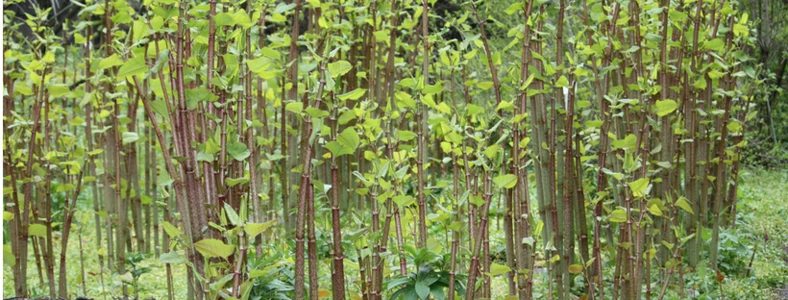Japanese Knotweed is a particularly nasty, invasive, fast-growing plant with a wide-ranging root system that can have a devastating impact on building foundations and drains. Although it can’t grow through concrete, the plant will force its way into any weak spots of buildings looking for light, causing walls, driveways and patios to crack and break apart. As its roots grow, they can damage and block underground drains, causing all sorts of plumbing problems in the property. In the most severe cases, knotweed can even cause subsidence.
Each plant’s roots can extend to 3m in depth and 7m in all directions, so if you have several plants, it creates an almost impenetrable network. It’s also very difficult to get rid of because if any trace of the root is left behind, it will quickly regrow.
How has it become such a big problem?
It was introduced to the UK from Japan back in the 1840s, when it was thought of as ornamental and sold to botanical gardens and high society individuals. Thirty years later, it became available to the public and was used by farmers for animal feed.
Before long, the plant ‘escaped’ and began to grow in the wild. In its native Japan, indigenous insects keep it under control, but in the UK there’s nothing in nature that can do a similar job, so it has continued to spread, growing by up to 10cm a day. It’s estimated that the damage caused by its roots and stems costs the economy around £166 million every year in weed control and property devaluation.
Today, Japanese Knotweed is considered a serious risk to properties and a garden pest. Because of the pervasive and destructive nature of the plant, if you have it on your property and are found to be failing to stop it spreading, you can be slapped with an Antisocial Behaviour Order and fined up to £2,500!
How do I know if I’ve got it?
Here are five distinguishing features of the plant:
-
- Large heart/spade-shaped leaves
- The leaves grow in a zig-zag pattern along the stem – i.e. they sprout off the stem on alternate sides
- Fleshy, red-tinged shoots
- In summer, it has clusters of cream flowers
- The stem is hollow and resembles bamboo
What could be the impact on the value of my property?
Essentially, it could make it very difficult to sell the property. If knotweed is flagged up on a survey, the buyer’s mortgage lender will typically ask for a specialist report to be commissioned at your expense The lender could then say that the property isn’t suitable for mortgage purposes, make a significant retention until it’s removed, or insist that the knotweed is completely removed before exchange of contracts.
Given the reputation knotweed has, you’re likely to find many buyers will be completely put off or, because it’s a relatively long and expensive process to get rid of the plant, they could reduce their offer.
How do I get rid of it?
Trying to dig it out is a losing battle, because it’s impossible to get rid of every bit of root. The recommended professional route is to have herbicides sprayed on the plant or injected into the stem, which is a 6-month process as you have to wait to see if it re-grows, and rather expensive, at around £1,500 for just a small patch and thousands to rid entirely from a garden.
If your tenants report they’ve found knotweed in the garden and you don’t believe it was there when they moved in, it could be the start of a difficult serious of conversations. If the tenancy agreement states that they’re responsible for looking after the garden and the knotweed has taken hold during their tenancy, technically they should pay for its removal, but it’s likely to be a tough one to prove.
One idea would be to take photographs of the garden at the start of the tenancy and if you see anything that you think could be knotweed, have a specialist carry out a survey. Some companies will do this initially for free but then charge a call-out fee if no knotweed is found – around £160-£180. Of those that do charge for the survey, the cost can usually be taken off the cost of any treatment works. There are a lot of cowboys operating in this industry, so do ensure you choose a qualified company who is a member of the Invasive Non-Native Species Association.
Then keep an eye out ongoing, particularly if there’s knotweed in the local area. Check at the start of spring and don’t waste any time in calling out an expert if you suspect you’ve got an invasion. Treating it at an early stage will keep the cost down.
There is good information about knotweed on the GOV.UK website and you can get practical help via the Invasive Non-Native Species Association.
Important information
There is no guarantee that it will be possible to arrange continuous letting of the property, nor that rental income will be sufficient to meet the cost of the mortgage.
Your property may be repossessed if you do not keep up repayments on your mortgage.
There may be a fee for mortgage advice. The actual amount you pay will depend upon your circumstances. The fee is up to 1% but a typical fee is 0.3% of the amount borrowed.

